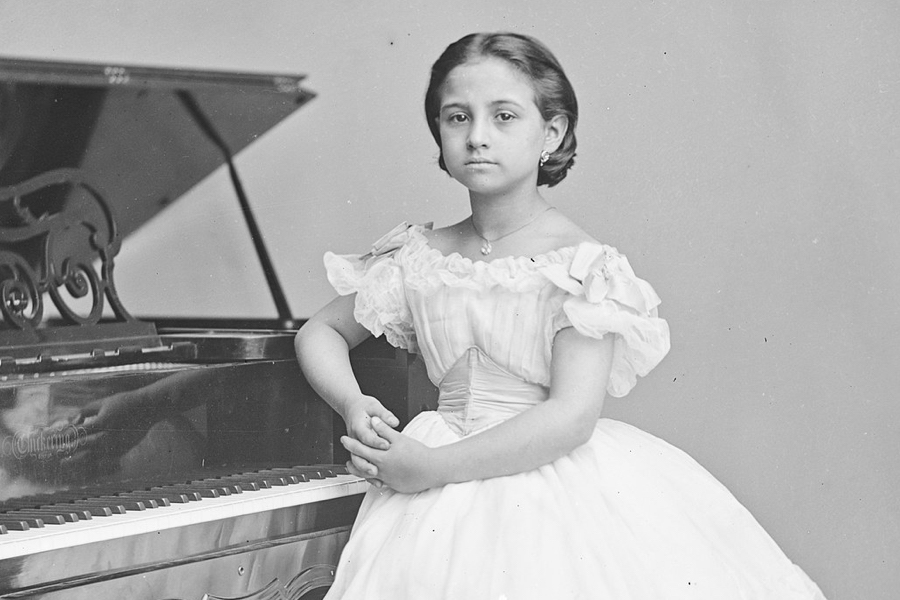Frédéric Chopin had a significant influence on the generations of pianists and composers who came after him, and South American composer Teresa Carreño was no exception. In addition to her work as a composer, Carreño was also a soprano, and, like Chopin himself, a pianist of towering virtuosity. She and Chopin had in common an ornate style of piano writing, and also wrote of lands to which they could not return: Chopin to his native Poland, which he fled at 21, after the failed nationalist uprising against the Russians, and Carreño to her home country of Venezuela, which was scarred by civil war and remained mired in political instability. Although she would briefly establish an opera company in Caracas, she lived the majority of her life abroad.
María Teresa Carreño García de Sena was born into a musical family in Caracas, Venezuela in 1853. Her grandfather, Cayetano José Carreño, had been the organist and choirmaster of a prominent church in Caracas. Her father, Manuel Antonio Carreño, was an accomplished musician who served as the Minister of Finance in the Venezuelan government. At the age of six, Carreño began studying piano under her father, who insisted that she practice drills in every key.

Teresa Carreño poses with her instrument at age 8
Amidst the turmoil of the Federal War, her father lost his government position and decided to move the family to New York in 1862. In their new city, Carreño began studying under eminent composer and pianist Louis Moreau Gottschalk, giving her public debut as a concert pianist at Irving Hall at age eight. A clear prodigy, she went on to perform across the United States and Cuba, including performing for President Abraham Lincoln in 1863. The family moved to Paris in 1866, where Carreño studied with George Mathias, a former pupil of Chopin, and also met Charles Gounod and Franz Liszt. Liszt apparently offered her lessons, which she turned down. She also studied voice with prominent musicians including Rossini. Between 1866 and 1872, she embarked on tours in England, Spain, and the Netherlands.

Portrait of Teresa Carreño in 1916
In 1872, she returned to the United States and toured extensively, occasionally also performing as an opera singer. In October 1885, Carreño returned to Caracas with her second husband, Giovanni Tagliapietra, to establish an opera company and music conservatory there at the behest of the Venezuelan president. Unfortunately, due to the ongoing political unrest, they had to abandon the project, returning to the United States in 1887. Two years later, Carreño decided to attempt to establish her reputation in Europe. She debuted in Berlin in 1889, leading to successful engagements in Europe, Australia, Africa, and the Americas. She had four husbands over the course of her life and had six children.
Carreño frequently performed Chopin’s works alongside the likes of Liszt, Schubert, Grieg, and Schumann. W.S.B. Matthews, an American music educator and critic, praised Carreño’s superior abilities as a technician, remarking that she could execute Bach, Chopin, Schumann, and Liszt with equal ease. “The solidity of her technique is such that all of these things are easy for her…It is no longer a reading, a recitation, a repetition of such and such compositions […]: it is music’s self.”
She recorded four works by Chopin on piano rolls, a type of recording technology that recorded each keystroke by punching a hole in a sheet of paper. The most sophisticated piano rolls, produced by the German company Welte, could also record the performer’s pedaling as well as the volume at which they played. Carreño’s recordings remain a testament to her impressive technique. Carreño’s piano roll of Chopin’s Ballade No. 1 in G minor, Op. 23 is a breathtaking example of this.
Teresa Carreño plays Chopin’s Ballade No. 1 in G minor, Op. 23, recorded on a Welte-Mignon piano roll in 1905, when she was in her early 50s.
Carreño not only performed the most complex Romantic piano music but also wrote in a similarly virtuosic style herself. The influence of Chopin is evident in her frequent use of her native country’s dance rhythms, such as the danza and valse criollo, just as Chopin had invoked the waltz and the mazurka, a Polish folk dance. Her Le Printemps (Spring), Op. 25 is a prime example of the valse criollo, a waltz style known for its “limping” rhythm and ample use of syncopation.
Like Chopin, she also favored genres that recalled the lyricism and sparkling virtuosity of Italian opera, such as the ballade—a genre that Chopin himself invented. Carreño’s Ballade, Op. 15 shares many features in common with Chopin’s style: singing melodies, a defined rhythm sustained by the left hand, and florid ornamentation.
Carreño’s otherworldly Ballade, Op. 15, performed by Clara Rodriguez
Carreño and Chopin also adapted other forms such as the barcarolle, a folk song sung by Venetian gondoliers. The barcarolle typically uses a lilting rhythm reminiscent of a boat rocking on the water.
One of the most virtuosic examples of the genre, Chopin’s Barcarolle in F-sharp Major is shot through with both exuberance and melancholy. Featuring the bane of all pianists—double trills—Chopin’s barcarolle is a tour de force in both technique and expression for any player.
At just 19, Daniil Trifonov handled the challenge of Chopin’s Barcarolle with grace at the 2010 International Chopin Competition
In Carreño’s “Venise: Rêverie-Barcarolle,” the swaying barcarolle rhythm emerges following an ethereal introduction, perhaps the reverie of the piece’s title. This piece is the first in her set of Sketches of Italy (Esquisses italiennes). Carreño’s barcarolle is a daydream, a pleasant trip down a Venetian canal on a sunny day.
Carreño enjoyed a performing career that spanned over 50 years. She was also an important advocate for emerging composers such as Edvard Grieg, who appreciated her playing so much that he sought her out as a soloist, and Edward MacDowell, an American composer whom she had taught as a young man. MacDowell later dedicated his Piano Concerto No. 2 to her. Chilean-born pianist Claudio Arrau heard her perform in Berlin in 1916, saying succinctly: “Oh! She was a goddess!” We’ll leave you with her charming “wrong-note” scherzo, La fausse note.



